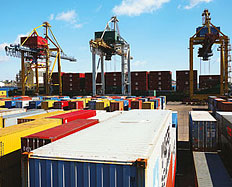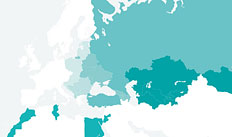COUNTRY ASSESSMENTS
Lithuania
HIGHLIGHTS OF THE PAST YEAR
- Lithuania recorded the EU’s second highest growth in 2011. The country benefited from good diversification in exports across markets and products. Relatively low household debt and a reviving labour market have supported private consumption, underpinning a balanced recovery.
- A mid-sized, locally owned bank was closed in late-2011. This was due to an isolated case of fraud and the bank’s closure and safeguarding of deposits was handled well by the authorities. This incident has nevertheless prompted greater attention to bank governance.
- The government has adopted an ambitious programme on raising skills and competitiveness. Among other measures, the programme aims to make improvements in the governance and transparency of state-owned enterprises.
KEY PRIORITIES FOR 2013
- More technology-intensive sectors that are oriented towards export markets should be developed. Knowledge absorption could be raised not just through policies aimed at domestic innovation but also through facilitating Lithuanian firms to establish a foothold in foreign markets.
- There is a need to further develop sources of equity capital outside the banking sector, such as private equity and venture capital. Risk-oriented and long term capital are sparse within a banking sector that continues to adopt tight credit standards and reduce foreign liabilities.
- Energy intensity of the Lithuanian economy remains one of the highest in the European Union and diversifying sources of energy supplies remains a key objective of the government. Energy efficiency investments will need to be stepped up, in particular in public buildings, and a wider set of regional electricity connections should be established.
MACROECONOMIC PERFORMANCE
In 2011 Lithuania experienced the second fastest expansion in the EU, as gross domestic product (GDP) grew by 5.9 per cent. This recovery from the deep recession of 2008-09 has been balanced between external demand and domestic private consumption and now enters its third year. Along with other countries in the region Lithuania showed a clear weakening in growth towards the end of 2011 following the renewed instability in the euro area. Growth figures for the first half of 2012 showed a reduced pace of about 3.5 per cent growth compared with a year earlier. Robust export growth is underpinned by much-improved competitiveness indicators. In early 2012 exports stood at 24 per cent above the level of 2008. With nominal wage reductions in the face of the financial crisis, real unit labour costs have fallen by about 7 per cent since early 2008, in contrast to several other central European countries. On the back of recovering corporate profits and regaining flows in credit to the corporate sector fixed capital investment has also recovered, showing a growth of 18.5 per cent in 2011. Unemployment, which peaked at over 18 per cent in mid-2010, has since dropped markedly (though it was still at 13.2 per cent in mid-2012). The labour market nevertheless remains a concern as youth unemployment stands at 24.8 per cent and the employment rate at only 60.7 per cent is significantly below the EU-wide target of 75 per cent.
Lithuania’s general government deficit remained precariously high in both 2010 and 2011. The country hence witnessed a rapid deterioration in its public debt indicators, with public debt now projected to continue climbing to a peak next year at just over 40 per cent of GDP. The authorities seek to comply with Maastricht deficit criteria already in 2012, notwithstanding the government’s somewhat lower growth expectations. These plans were backed up in 2011 through a four per cent across-the-board spending cut. Given excessive pre-crisis foreign funding, banks in Lithuania continue to reduce external liabilities, last year at a rate of about 3 per cent of GDP.
Short-term growth prospects are constrained by internal and external factors. As in the other Baltic economies the constraints in credit availability coupled with weakness in export markets will likely keep growth below 3 per cent this year and next. While the government is committed to a timeline for accession to the European Monetary Union (EMU) in 2014, it remains opposed to using indirect taxes and administered prices towards that end.
MAJOR STRUCTURAL REFORM DEVELOPMENTS
Lithuania has revived its efforts in structural reforms. Most of its policy ambitions have been articulated under the National Reform Programme which was updated in April 2012, and assessed by the EU Council, based on a proposal by the European Commission. The updated programme identifies some well-known obstacles to growth – principally, imbalances in the public finances, still insufficient competitiveness and productivity, problems in the business environment, underdeveloped infrastructure and high unemployment.
The government is taking steps to level the playing field for investors. These measures are taken in light of the ongoing concerns of private investors over governance issues and competition from the informal sector. The government continues to hold numerous stakes in state-owned companies, importantly in the energy, transportation and postal services sectors. For these companies there has been some progress in improving transparency and strategic planning. The Reform Programme underlines the fact that this sector has shown good revenue growth and has returned to profit in 2011. A full separation of regulatory functions from the ministries which also manage the ownership stakes in these enterprises remains the government’s ambition.
The national reform programme emphasises the need to raise competitiveness. The programme targets technology-intensive production through stimulating research and development. Private equity, which could be instrumental in providing seed capital for young and innovative firms, remains underdeveloped. The government’s programme recognises the long-term nature of many of these plans, for instance in raising participation in the labour market, improving standards in education and training or in the development of clusters of innovative technologies. Education expenditure in Lithuania is already among the highest in the CEB region. However, the European Commission’s 2012 Ageing Report suggests that over the next 50 years Lithuania’s total population will decrease by 19.6 per cent with a parallel drop in the total workforce of almost 36 per cent. As a result, the dependency ratio (population aged 0-14 plus 65 and over relative to the workforce aged 15-64) is expected to increase from 45 to 82 per cent over that period.
The energy sector remains a focus of the government’s work. In 2010 the government adopted the Energy Independence Strategy, which is aimed at expanding generation capacity, raising energy efficiency and securing supplies through the connection to markets in continental Europe. In line with these plans some consolidation in the domestic electricity operators was implemented in 2011. The need to diversify sources of energy supply and enhance energy security has emerged as a major challenge following the closure of the Ignalina nuclear power plant and the uncertainty over the reliability of gas supplies from Russia, from where all gas is imported. In May 2012 the government gained full control over the gas distribution network within the country and in July an agreement on the construction of a floating LNG terminal in the port of Klaipeda was reached, which bodes well for the government’s energy independence strategy. Plans for a new nuclear power plant have progressed but were subject to a referendum in October 2012.
In the financial sector, the authorities are keen to put in place a regulatory framework that will prevent the excesses of the previous lending boom. The personal bankruptcy law was streamlined, and in September 2011 a regulation for responsible lending was adopted that aims to prevent the re-emergence of unsustainable credit and house price developments. The failure of a mid-sized local bank (Bank Snoras) in November 2011 motivated greater government attention to the governance and business models of locally owned banks. The bank’s failure was due to an isolated case of fraud, but it briefly eroded depositor confidence in the viability of the few remaining locally owned banks, as was evident in deposit flight from such institutions immediately following this incident. This bank closure was handled expeditiously and all retail deposits of Snoras were honoured, though as a result of the closure of the bank the public sector has assumed a liability of at least 2.5 per cent of GDP in excess of the assets in the deposit insurance fund.







